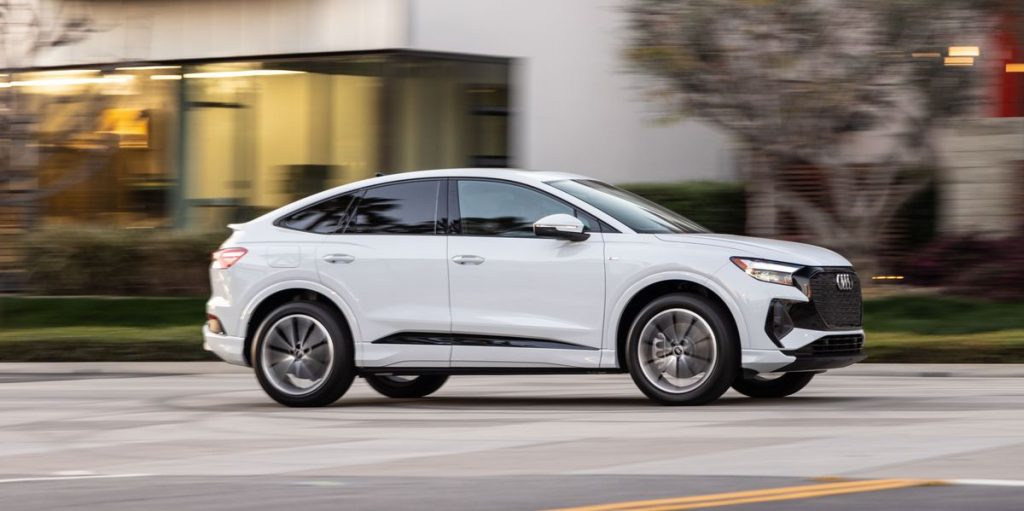2022 Audi Q4 e-tron Doesn’t Push the EV Envelope

If, as we’re repeatedly told, electric vehicles become the norm, then how weird should EVs try to be? Right now, they’re still a novelty, so we kind of expect some wackiness in their design or operation, but plenty of drivers coming out of conventional cars probably won’t want to deal with more change than necessary. The Audi Q4 e-tron is an EV for them.
Smaller than the mid-size Audi e-tron SUV that has been on offer since 2019, the new Q4 e-tron looks very Audi-esque. Like the larger e-tron and the gas-powered Audi Q5, the Q4 is offered in standard (SUV-shaped) and Sportback body styles. It has the Audi hex-shaped grille aperture, here closed off due to reduced cooling needs. Neat creases are ironed into the sheetmetal, as in other Audis. A light bar connects the taillights—another Audi signature element—and features turn-signal animations. The brand’s matrix LED headlights are on hand, though here they offer a new wrinkle: Drivers can choose among four different light signatures for the daytime running lights.
At 180.7 inches long, 73.4 inches wide, and riding on a 108.7-inch wheelbase, the Q4 effectively splits the dimensional difference between the conventionally powered Q3 and Q5 SUVs. Its size almost exactly matches that of its platform-mate, the Volkswagen ID.4.
Because the Q4 e-tron shares its platform with the ID.4, the mechanicals are familiar. For the dual-motor, all-wheel-drive variant (the only configuration built during the abbreviated and now-concluded 2022 model year), that means an output of 295 horsepower along with 339 pound-feet of torque. As in the VW, a 77.0-kWh battery pack feeds the powertrain (Audi skips VW’s price-leader 58.0-kWh battery option). For 2023, the Q4 adds a rear-motor, rear-drive entry-level model (for the SUV only, not the Sportback), and its 201 horses also mirror the VW.
Q4 e-tron Design and Interior
The Audi’s exterior design, though, looks nothing like the ID.4’s, and the same is true of the interior. Instead, the Q4 interior picks up themes from other recent Audis. That means a digital instrument cluster is standard, and the central touchscreen (10.1 inches in ’22 models, 11.6 inches in ’23s) is canted toward the driver. An unusual, nearly hex-shaped steering wheel comes with the Black Optic package—as do sport bucket seats and aluminum-look trim. Otherwise, the Q4 gets a real wood inlay perched at the leading edge of the dash.
There are some innovations here: The toggle-style shifter is located on a projection that juts out from the dash, and there’s open storage underneath. The door armrests incorporate a slot for those water bottles that everybody carries around. Some choices are questionable, like the four-way flat disc that offers basic audio controls; you trace a finger around its outer edge to (awkwardly and imprecisely) adjust the volume. Swipe-touch controls open and close the sunroof and shade, and more are on the steering wheel, but those also respond to a press of the finger, making them less annoying to operate. The Audi MMI home screen can show three functions at once, and the system typically displays a column of touchpoint shortcuts to main functions along the left-hand side of the display. The optional head-up display adds augmented reality, which means an arrow animation floats in front of the driver when it’s time to make a turn. (That’s exclusive to the Prestige trim and can be switched off.)
Sitting behind the wheel of a Q4, you look out over a large dashtop, as the base of the windshield is far forward, almost like in a minivan. Rear visibility in the Sportback—which is the version we drove—is less compromised than in most SUV “coupes.” There’s just enough rear-seat headroom for a six-foot passenger, and legroom when sitting behind a similar-size driver is more than adequate. Unusually, the Sportback has slightly more cargo volume than the SUV model (at least when measuring per the EPA guidelines): 26 cubic feet behind the rear seats and 54 with them folded, beating the standard model in both cases by 1 cubic foot. Of course, the SUV version will be better able to carry bulky items. The MEB platform doesn’t allow for a frunk, but there is stowage under the rear load floor, which can be set level with the liftgate opening or positioned a few inches lower.
Driving the Q4 e-tron
The dual-motor Sportback—mechanically identical to its SUV-shaped counterpart—is quiet underway, its drivetrain emitting none of the spacey whirring noises you sometimes get in an EV. We’re growing accustomed to EVs capable of neck-snapping takeoffs, but that’s not the case here. The Q4 squirts off the line, but as speeds build, its response grows less lively. Floor it for a two-lane pass at 55 mph or so, and it gathers speed slowly. This powertrain is good for a 5.4-second 60-mph sprint in the VW, and we’d expect perhaps 5.3 seconds here. That may not sound particularly lazy, but consider that the dual-motor Hyundai Ioniq5 and the Kia EV6 GT-Line pack 25 more horses and need just 4.5 seconds to hit 60.
One-pedal driving, that EV novelty, isn’t offered here, Audi’s philosophy being that most drivers find it hard to do smoothly. Drivers can use the steering-wheel paddles to cycle through four levels of regen: none, 0.06 g, 0.10 g, and 0.15 g, the latter being equivalent to the shifter’s “B” setting. Even in this highest setting, the driver must step on the brake pedal to bring the Q4 to a stop. When in Dynamic mode, your paddle-selected level of regen stays until you change it; in any other drive mode, the paddle-selected level of regen resets to zero as soon as you get back on the accelerator. That seems strange, but Audi claims higher levels of regen are less efficient than letting the car optimize between coasting and regen based on sensors and nav data.
Admittedly, the amount of accelerator lift-off regen is largely a concern for EV nerds and not for most drivers, who will be fine with a vehicle that coasts when the accelerator is released, just like their gas car does. But one reason why we preferred the higher level of regen here is because the Q4’s brake-pedal action is not so satisfying. As in the ID.4, there’s lots of pedal travel, making modulation somewhat of a challenge.
The suspension of struts up front and a multilink rear setup uses passive dampers, and the tuning is taut. Still, the ride was comfortable and not overly firm, at least on the gentle pavement of greater San Diego, which doesn’t serve up much of a challenge—potholes are anathema to the area’s pleasant, mellow vibe. We wouldn’t go so far as to call the chassis sporty, however, as the Q4 feels hefty when hustled through curves, and the steering while decently weighted also seems artificial—a Mustang Mach-E is a more engaging dance partner. The Q4 is highly maneuverable, however, with the all-wheel-drive version boasting a tight, 37.7-foot turning radius; the RWD variant is even better at 33.5 feet.
Q4 e-tron Range and Charging
The dual-motor, all-wheel-drive Q4 is EPA-rated at 241 miles of range—that’s for the 2022 model year. The 2023 version, which has not yet been blessed by the EPA, should deliver slight revisions: 236 miles for the SUV body style and 242 for the Sportback. That’s not quite as good as the similarly configured EV6 (274 miles) but better than the Volvo XC40 Recharge (223).
The Q4’s best range results are from the single-motor 2023 model, which is good for 265 miles. The Koreans get a lot more range from their similar-sized battery, however: 303 miles in the Ioniq 5 and 310 miles in the EV6.
Nor is the MEB platform able to accept as high a rate of recharging as the Hyundai/Kia. The Q4 can support DC fast-charging up to 125 kW, which Audi says will take the battery from a 5- to 80-percent charge in 36 minutes. The on-board charger is rated at 11 kW, and the included charge cord comes with pigtails for 240v and 120V outlets. As the VW Group provides major funding for Electrify America (thanks, Dieselgate!), Q4 buyers are gifted 250 kwh of charging on that network.
Originally slated to go on sale in late 2021, the 2022 Q4 e-tron was tardy getting here (it didn’t reach dealerships until the end of the summer) and is now about to be replaced by the 2023 model. Other than the arrival of the Q4 e-tron 40 single-motor variant and a slightly larger MMI screen for all Q4s, the 2023 version just sees tweaks to feature content. The S Line appearance package becomes standard on dual-motor models, and navigation is included with the Premium Plus package.
With the arrival of the single-motor variant, the 2023 version of the Q4 will start at just $49,995, and dual-motor variants can be optioned into the mid $60,000’s. That overlaps the XC40 Recharge, which is considerably more powerful but has less range. The Tesla Model Y is considerably more expensive but has more range. The Q4 is not that much more costly than its VW sibling, and while the two are mechanically similar, the Audi is more stylish outside and has a superior driver interface inside. It’s not a headline-making EV, but for premium-SUV shoppers ready to make the leap, it may be enough.
Specifications
Specifications
2022 Audi Q4 e-tron
Vehicle Type: front- and rear-motor, all-wheel-drive, 5-passenger, 4-door wagon
PRICE
Base: 50 Premium quattro, $51,095; Sportback 50 Premium quattro, $53,895
POWERTRAIN
Motors, F/R: induction asynchronous AC/permanent magnet synchronous AC
Combined Power: 295 hp
Combined Torque: 339 lb-ft
Battery Pack: liquid-cooled lithium-ion, 77 kWh
Onboard Charger: 11 kW
Peak DC Fast-Charge Rate: 125 kW
Transmissions, F/R: direct-drive/direct-drive
DIMENSIONS
Wheelbase: 108.7 in
Length: 180.7 in
Width: 73.4 in
Height: 64.0-64.7 in
Passenger Volume: 95-97 ft
Cargo Volume: 25-26 ft
Curb Weight (C/D est): 4860-4880 lb
PERFORMANCE (C/D EST)
60 mph: 5.3 sec
1/4-Mile: 14.1 sec
Top Speed: 112 mph
EPA FUEL ECONOMY
Combined/City/Highway: 95/100/89 MPGe
Range: 241 mi
A car-lover’s community for ultimate access & unrivaled experiences. JOIN NOW

This content is imported from OpenWeb. You may be able to find the same content in another format, or you may be able to find more information, at their web site.




